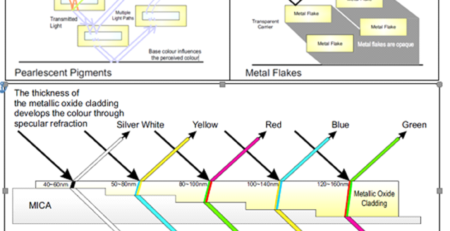Pearl Pigments
Pearl pigments – types
There are three main types of pearl pigments. The main difference is in the materials used to make them. They are;
• Natural / mineral mica
• Synthetic mica
• Glass flakes
Let’s look at them in detail.
Natural / mineral mica
Natural / mineral mica is extracted from places with a high content of silica. Some deposits do not have natural mica with any color and luster during mining. Such mica is ground to a fine powder, which is the pearl pigment.
When it is necessary to improve the color and luster, the mica is coated with metal oxide. Titanium oxide is one of the most commonly used oxides. This improves the light effects of the mica and gives it a more saturated color and a brighter shine.
Synthetic mica
Synthetic mica is used to produce pearl pigments in the same way that natural mica is used. The artificial mica thus formed consists of crystalline compounds such as silicon oxide and alumina. Characteristic of these compounds is that their molecules are held together in layered plates. They lie on top of each other and have different refractive indices. Synthetic mica has the same properties as natural mica.
Synthetic mica has no natural color or luster. Color and luster are obtained by coating with iron or titanium oxide. Synthetic mica pigments are more expensive than natural mica pigments because their production process is longer. Due to the richer color and bright shine, they look much better than natural mica pearl pigments.
Glass flakes
Pearl flakes of glass flakes are made of clear and transparent crystals of calcium aluminum borosilicate. Their production is similar to that of synthetic mica. Pearl pigments obtained from transparent glass flakes look more shiny and sparkling. Because glass flakes have no impurities to prevent light from refracting, even before a layer of metal oxide is added for coloring, they have a sparkling bright luster. They are best suited for making chameleon pigments.
You’ve probably been fascinated by pearlescent pigment surfaces that change color like a chameleon. This pearl paint is Color-Shift or interference pearl pigments. They change color depending on the angle of view. Color-Shift pigments have several different layers. When you look at different angles you will see different reflections and hence different colors. The color changes as the wavelength changes. Colors will shift to shorter wavelengths when the angle of view shifts from sharp to perpendicular.
Interfering pigments
Interfering pearl pigments are coated with titanium oxide or iron oxide. These compounds are highly refractive and reflective and these properties depend on the wavelength of the light falling on them. They will refract or reflect light rays before touching the pearl pigment. Upon falling on the pearl pigments, the light is scattered in many directions. This results in a wide range of colors as a result of interference from reflected or refracted ore rays.
Iron oxide has its own reddish hue, at the same time it absorbs some of the light, instead of anger it reflects the whole. Silicon oxide is also used to coat the pearl pigment. It allows a more noticeable change in color depending on the angle of refraction. Its low reflectivity is a challenge when a certain color scheme is desired, which can be overcome by adding a coating of highly reflective material on the silica flakes. The use of aluminum achieves the color of pearl pigments and adds shiny metallic reflections.





Leave a Reply
You must be logged in to post a comment.